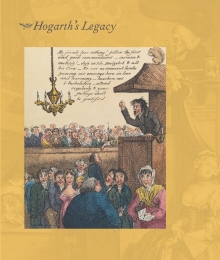Cynthia Ellen Roman, ed. Hogarth’s Legacy. New Haven and London: Yale University Press, 2016. xl, 259p., 108 ill. ISBN 9780300215618. US$ 60.00 (hardcover).
Cynthia Ellen Roman’s edition of collected essays on the legacy of the English engraver, printmaker, and painter William Hogarth (1697-1764) is a timely tribute to one of the most iconic figures of the eighteenth-century visual satire, 250 years after the artist’s death. The collection focuses for the first time on Hogarth’s afterlife in Britain and abroad by bringing together eight contributions by a multidisciplinary team of scholars. In a beautifully illustrated volume containing 108 artworks by Hogarth (or copies after the artist’s prints), many of them held in the Lewis Walpole Library’s outstanding collection, the editor successfully illuminates the multifaceted nature of Hogarth’s art and his enduring influence on the development of graphic satire during the eighteenth century and beyond.
There are many reasons to praise this elegant collection, some of the most important being its illustrious contributors and the range of topics covered. Art historian Douglas Fordham opens the book with an essay on “Hogarth’s Act as the Professional Caricaturist” in which he unveils the artist’s role in the passing of the Engravers’ Act of 1735, also known as Hogarth’s Act, which is one of the most enduring legacies of the artist. Proposing that the value of a print lies not in the paper but in the “design,” which necessarily goes beyond the simple copy of one’s work, the Engraver’s Act created opportunities for the emergence of the professional caricaturist in England, outstandingly represented by James Gillray and George Cruikshank later on. In “Copying The Sleeping Congregation: Hogarthian Innovations and the Rise of Graphic Satire,” Cynthia Ellen Roman explores the “persistent history” (51) of copying the artist’s work as fostering innovations in graphic satire. The chapter uses as a case study one of Hogarth’s most famous visual satires to discuss the role of copies, translations, borrowings, and appropriations in forging Hogarth’s pictorial legacy, and aptly complements the opening chapter by shedding new light on Hogarth’s role in protecting printmakers’ rights. In an elegantly written chapter, historian Mark Salber Phillips considers a less explored aspect of Hogarth’s legacy: his work as a history painter. Looking at the artist’s paintings for the stage as a road to history painting, Phillips discusses the former’s satiric realism and the latter’s elevation of style as exemplifying Hume’s notion of “contrariety,” a process whereby Hogarth’s ironic commentary subtly infuses the visual language of his classical and biblical “histories.” In “Hogarth Moralized? Hogarth’s Presence in Nineteenth-Century Mass Circulation Print Culture,” historian Brian Maidment addresses Hogarth’s reception during the Victorian era by looking at series of articles on his work published in mass circulation periodicals between 1820 and 1850, as well as by examining The Curse of Mammon(1839) by playwright Thomas H. Reynoldson and The Days of Hogarth: or, The Mysteries of Old London (1847-1848), by novelist G. W. M. Reynolds. The author argues that these interpretations of Hogarth’s work or reconstructions of Hogarth the artist in the first half of the nineteenth century answered the market’s demands for educational, moral, and cultural values and reimagined the artist for a new audience. In “Hogarth ‘Corrected’: Modern Moral Subjects in France,” art historian Patricia Mainardi explores Hogarth’s reputation in France and his influence on several French satirists. Such artists include Jean-Baptiste Greuze, or “the French Hogarth,” whose work is insightfully analyzed in this chapter, as well as Louis-Léopold Boilly, Rodolphe Topffer, Emile Wattier, Victor Adam, Edmé-Jean Pigal, and Edouard Charon, who “corrected” or emulated Hogarth the caricaturist (a title with which Hogarth would have strongly disagreed). Michael Printy’s chapter explores Hogarth’s reception in Germany though the lenses of physicist Georg Christoph Lichtenberg who, in his Hogarth Commentaries (1794), provides close readings of Hogarth’s major print series and a few stand-alone pieces. Printy aptly places Lichtenberg’s work in the context of the physiognomy debate started by Lavater’s influential Fragments, highlighting his use of “pathognomy” (Lichtenberg’s more capacious term describing “the entire semiotics of emotions”) in analyzing Hogarth’s prints, and describing the German author’s work as a sort of “social physics” dealing with the study of human behavior and motivation. Dominic Hardy’s chapter looks at the circulation of Hogarth’s artworks and aesthetic ideas in North America after the Revolutionary War following two lines of enquiry. First, the author traces down Hogarth’s presence in post-revolutionary America to prove that Americans appropriated the messages of Hogarth’s satires in general, and of the Wilkes image, in particular, as “emblematic of political resistance to British tyranny” (202). According to Hardy, Americans were deeply influenced by Hogarth’s aesthetic ideas, as described by the artist in The Analysis of Beauty (1753). Second, the author looks at Hogarth’s presence in the public sphere as reflected by references to his work in the newspapers of the time to explain the ways in which art production and consumption operated in America as compared to Europe. Finally, the collection ends aptly with a chapter by distinguished Hogarth biographer Ronald Paulson, who discusses the importance of George Steevens’s compilation of Hogarth’s works, together with his commentaries, in assessing the artist’s legacy.
The collection stands out not only for the quality of contributions but also for its cohesiveness: various authors address aspects of Hogarth’s heritage from different disciplinary perspectives (e.g. Hogarth’s distinction between character and caricatura, his contribution to the Engravers’ copyright act, etc.), which creates the impression of a lively dialogue that illuminates the object of investigation. The volume is also generously illustrated and its large format allows for clear and detailed reproductions. The only drawback that this reader found is the absence of a list of illustrations, which would have helped readers identify them more easily (especially given that more than one author refers to the same image). This is, however, just a minor observation that does not take away from the truly superb contribution that this collection makes to Hogarth studies.
Ileana Baird
Zayed University


